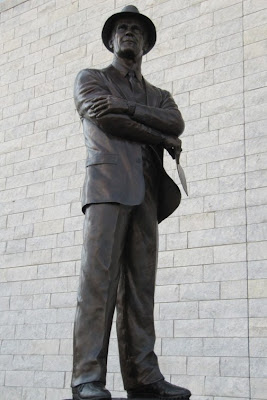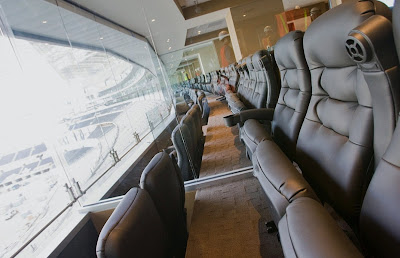
The $1.4 billion Cowboys Stadium in Arlington, Texas opened in May 2009. The domed stadium features an expansive retractable roof, the world's largest HDTV video board, and the largest retractable end zone doors in the world. The stadium has seating for 80,000 expandable to 110,000, 381 luxury suites, club seating on multiple levels and three standing room only areas for 15,000 fans above the end zones. It is the 3rd largest stadium in the NFL by seating capacity. 180-foot-wide by 120-foot-high glass doors, located at each end of the stadium, allow each end zone to be opened.
Tom Landry statue in front of the stadium.
The stadium is the largest domed stadium in the world and has the world's largest column-free interior. The Statue of Liberty and its base would fit inside the stadium without touching the retractable roof. The stadium requires three electrical power substations plus backup generators and averages roughly $200,000 in monthly utility bills. When it is in full summer operation it uses more electricity than all of the high rise buildings in Fort Worth.
The field is actually 50 feet below ground level, so fans entering on the plaza level will have a panoramic view over the field. The end zone areas have the flexibility to convert from standing-room only to seating, based on specific event needs. The maximum seating capacity is approximately 110,000.
The new stadium has more than 3,000 Sony LCD displays throughout the luxury suites, concourses, concession areas and more, offering fans viewing options that extend beyond the action on the field, and a center-hung four-sided video display board that contains two of the largest high-definition television screens in the world. People frequently refer to the video board as the "Jerry-Tron" or the "Jumbo-Tron". It actually consists of four separate screens: two 160-by-72 foot main screens and two 48-by-48 foot screens for the end zones. The video board was originally fixed at 90 feet directly above the center of the playing surface. After the Tennessee Titans punter hit the board during the Cowboy's first preseason game and first game ever played at Cowboy Stadium in 2009, the board was retrofitted so that the board height could be varied from 35 to 100 feet. The video board weighs an astounding 1.2 million pounds and reaches a span of seven stories in height and spans from 20 yard line to 20 yard line. The video board cost $5 million more than the entire construction of the old Texas Stadium.
The 410 foot long by 256 foot wide retractable roof was open when we started our tour. Later as clouds started moving in they closed it. Closing the two roof panels takes about 10 minutes. Not bad considering that each panel is 215 feet long and consists of 14,100 tons of structural steel. During NFL games the Cowboys do not control the retractable roof – the NFL controls whether it will be open or closed.
This photo shows a view of the three standing room only areas above one of the end zones. The areas are above the seats under the Dr. Pepper, Ford and AT&T signs. Each area has a capacity of 2,500. $29 Party Pass tickets gives fans access to these standing room only areas.
This is a view from one of the upper deck end zone standing room only areas. It shows one of the 48 foot screens on the video board.
The facility has a permanent maintenance staff of 6,000 and six different surfaces that can be installed in 12 hours. This allows the stadium to be used for a variety of activities outside of its main purpose (professional football) such as concerts, religious ceremonies, basketball games, college football and high school football contests, soccer matches, motorcross races and rodeos similar to the Houston Livestock Show and Rodeo. For basketball events played in Cowboys Stadium, such as the 2010 NBA All-Star Game, the video board is actually larger than the court and the video board is lowered to 35 feet. The highest the board has ever been raised was 100 feet for a U2 concert. The video board was not used during the concert but had to be raised to make room for their large claw shaped stage.
This telephoto of Ameriquest Field, the Texas Ranger's stadium, was taken from one of the top deck standing room only areas. The traditional, red brick baseball stadium is an interesting contrast to the futuristic Cowboy Stadium.
Player lockers.
The cheerleaders have their own lockers in the new stadium.
The previous photo is a view from one of the luxury suites. There are 381 luxury suites on five different levels with leases ranging from $100,000 to $500,000 per year. The suites range in size from 650 to 800 square feet and seat up to 45 fans. The suites have leather-clad walls, bars with Brazilian granite tops, custom leather furniture and private restrooms.
Seating in one of the larger luxury suites.
The luxury suite lessees and their guests can enjoy catered gourmet foods prepared by 12 chefs, private entrances, private parking, tickets to Cowboy home games and access to exclusive clubs in the stadium.
Tickets: Dallas surpassed New England and now has the most expensive tickets in the league. They average $160, an increase of 90% from last season. The sticker shock doesn't end with the cost of tickets, however. The Fan Cost Index -- what it takes to bring a family of four to a game -- is $759 in Dallas, by far the highest in the league. The Patriots check in with the second-highest FCI at $597, and the league average is $412. The biggest bargains in the NFL can be found in Buffalo, where tickets average $51 and the FCI is $304, and in Jacksonville, $57 and $310.
Parking: Jones and the Dallas Cowboys control all of the premium parking lots around the stadium. Parking passes are available with certain tickets and start at around $50 – $75 dollars and the price goes up from that. Parking at the nearby Texas Ranger's Stadium cost is $20-60. Downtown Arlington parking is available for $25 or less but there are no shuttle buses to the stadium which is 1.4 miles away.
Concessions and merchandising sales: The New York Yankees and Dallas Cowboys, two of sports' richest teams, have partnered with Goldman Sachs Group and private equity firm CIC Partners to create Legends Hospitality Management, a sports services company that will operate the concessions and merchandising sales at the new Cowboys stadium in Arlington, Texas, and at the new Yankee Stadium in the Bronx, New York, along with the stadiums of the Yankees' minor league affiliates.
The Art Program At Cowboys Stadium is an art program at the stadium that launched with 14 commissioned artworks by renowned artists, which have been installed in prominent locations throughout the Stadium. Franz Ackermann, Annette Lawrence, and Olafur Eliasson are among those who have created new work for the program. When Jerry Jones and his wife, Gene, announced the Dallas Cowboys Art Program, an initiative to commission and install contemporary art throughout their new football home, Cowboys Stadium became the latest sports facility to double as a gallery. Our 1-hour tour did not include visits to areas displaying art.














